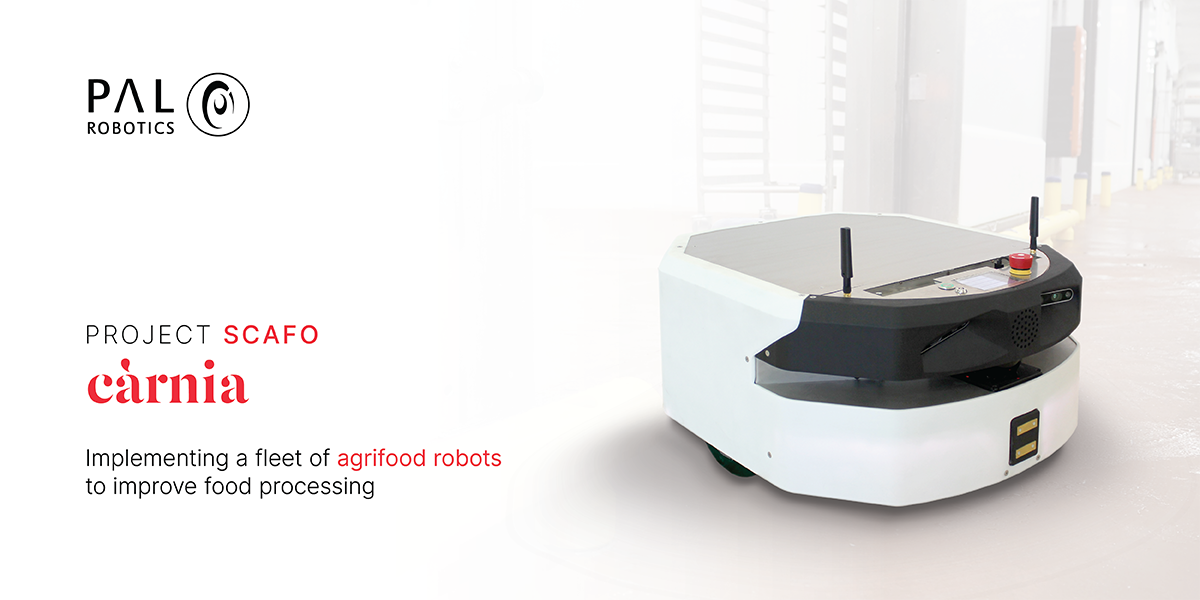Recently the team at PAL Robotics participated in the EU project SCAFo, with the aim of introducing AMRs (Autonomous Mobile Robots) to the fast-paced food production industry and demonstrations at the meat production plant, Carnia. There are many environmental challenges that robots face in the agrifood industry, including low temperatures, high humidity, and multiple human workers in the workspace. With those in mind, PAL Robotics developed a new base robot to take part in the project. Read more about the SCAFo project, the tasks for AMRs at Carnia, and the potential for robotics to improve the food production and processing sector.
Time matters: more efficient operations in food processing to improve quality and limit waste
Focusing on the food processing industry, time often matters, and more efficient operations can improve quality, limit waste, and increase company profits by lowering operational costs.
Automation, including robotics, has a huge potential to improve operations in the fast-paced and dynamic food production industry. Automation can also help a business operate better and faster when developed and deployed correctly.
Automation does not mean that a company could – or should – replace its workforce. Instead, modern automation systems and machines can work alongside human workers, helping them create more efficient processes and workflows, and reducing the number of tedious and tiring tasks they need to do.
Use case: SCAFo project tasks at Carnia including transportation of stored meat to a workstation
The main objective of the EU-funded SCAFo project has been to facilitate the introduction of a fleet of AMRs based on developing an updated version of PAL Robotics’ established TIAGo Base robot model to perform food transportation tasks in the unstructured and dynamic environment of the food processing industry.
At Carnia, PAL Robotics implemented the robotic solution in a transportation area to take stored meat from a freezer room to a workstation where it was then processed. One of the main goals of this pilot was to allow the workers that do the repetitive tasks of transportation to work on other tasks of higher value.
Jordi Tonijuan, Production Director at the food production plant, C.G Carnia whose work includes the processing, sale and distribution told us, “in our day-to-day work, we have a worker preparing the goods, and piling them in boxes in the walk-in freezer, and a second worker comes in to transport the goods, to the workstation which can be 15 or 20 metres away. The worker repeats the process back and forth, up to 60 times per day.”
Jordi continued, “most of the time, what happens next is that the workers try to optimize each run, loading too many goods, instead of carrying 10 boxes per run, they carry 20. This means that the goods are left out of the freezer more hours than needed before processing. That is an important fact due to the change of temperature and could potentially impact on the product.”
The introduction of a fleet of AMRs in agrifood: challenges including environmental conditions
The challenges faced during preparations in the SCAFo project pilot were common to the food industry and in particular, were the environmental conditions. These included:
- Condensation, high humidity and low temperatures in the working areas with unevenness in floor surfaces impacting on the drainage of water – this could affect robot operations in the plant
- A variety of boxes sizes and requirements for the robot meat delivery tasks
- Doors that open manually and not automatically – impacting on robot navigation in the production plant.
A new intralogistics robot: developing a robust solution ready to operate in harsh conditions
The new base robot created for the agrifood project addresses all the relevant key abilities needed by service robots in the market today for semi- or full autonomy in an environment collaborating together with human workers. The robot was designed to ensure robust operations and to meet the environmental challenges, featuring:
- A robust base that carries payloads of up to 150kg
- A new robot body structure that better adapts to the transportation of processed food
- Robot covers with a manufacturing technique that avoids the growth of bacteria
- Robot covers designed to avoid water entering the platform from the bottom
- Developments of the human-aware navigation system which allows the robot to move and share the same workspace as human operators easily
- Implementation of visual programming on the platform so the robot can be used by non-technical workers.
The agrifood robot is able to operate in any indoor environment, and in particular, is suitable for use in harsh conditions. The improved suspension system, along with safety lasers and a wider field of view (2 embedded RGB-D cameras) also allow for safe and easy operation. The provided visual programming of tasks also enables easy deployment and control of the solution, as well as collaboration with people and fleets of robots.
Results: optimising the transportation flow of the goods
Following the SCAFo project pilot, Jordi Tonijuan at Carnia told us, “thanks to the implementation of the PAL Robotics solution, we have optimised the transportation flow of the goods, freeing workers to perform other tasks due to the robot’s execution of the repetitive tasks, we can prevent the goods from being out of the walk-in freezer more time than needed and avoid too many changes in temperature which could impact on quality.”
The SCAFo project is an agROBOfood project that received funding from the EU. At PAL Robotics we partner in a number of collaborative projects in areas such as: agrifood, healthcare and ambient assisted living, as well as projects covering areas such as smart cities and factories of the future, read more in our previous blog post. We are always on the look for new collaborations, to find out more about EU-funded projects or request information, visit PAL Robotics’ collaborative projects webpage and don’t hesitate to get in touch.
